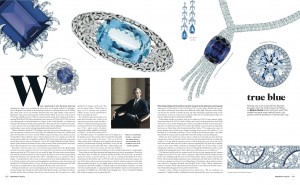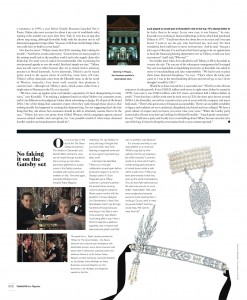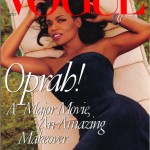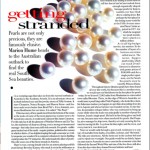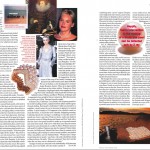True Blue
Nobody was more surprised than Michael Kowalski when he got the top job at Tiffany. As Marion Hume writes, during his watch the retailer has made some radical moves in its quest to sell fine jewellery in a ‘democratic’ way.
The Austalian Financial Review | November 2012
by Marion Hume
What a swell party it was. The brass band was swinging, the singers were crooning, the dance floor was hopping, fuelled by champagne. Above the granite and marble of the imposing main floor, a towering interior was lit Tiffany blue, while views out of vast windows showcased the rainy night sparkle of the streets of Manhattan. They say the opening of the worldrenowned Tiffany & Co. store at the corner of 57th Street and Fifth Avenue in 1940 was a glorious affair, despite the US being on the brink of entering World War II. The above description is not, however, of 1940 but 2012. The vast views were photographs to bring Manhattan to Prague, in the Czech Republic, to celebrate the opening of the American jeweller’s latest global store. That said, the vibe was glamorously retro, a warm contrast to the usual chilly fashion parties where guests dripping in borrowed brand merchandise are more intent on Instagramming than kicking up their heels.
Tiffany should have ended its 175th birthday year with an even more marvellous party – one that was supposed to feature movie stars, Moet, two inflatable zebra lilos and a fabulous pool party. For December was to have seen the Tiffany marque writ large across cinema screens in 3D. But Warner Bros stalled the release of Baz Luhrmann’s The Great Gatsby, for which the jeweller has provided scores of sparklers, until May 2013. Surely news of the delay was exactly what Tiffany did not want for Christmas? “Not at all!” laughs Michael Kowalski, Tiffany’s quietly spoken chairman and chief executive, when we meet on the morning before the Prague party in the leafy garden of one of the Czech Republic’s swankiest hotels.
Kowalski, it must be said, is not a swanky kind of guy, despite the locale. Bespectacled, married to the same woman for 35 years, you’d read the 61 yea rold more as the dependable numbers guy than the CEO, which, in a way, would be right. His route to the top was finance and, when he reached the pinnacle in 1999, at age 48, he claims no one was more surprised than himself. He still doesn’t act much like other CEOs – although he has a car and driver while in Prague. “I actually prefer to rent my own car because just the act of understanding where a store is, in relation to airport or downtown and navigating by yourself, gives a sense of awareness and familiarity. Or I’ll take the subway,” he says. On the way back from the Prague party, he’ll offer several guests a chauffeur-driven ride, meaning he will perch in the centre rear seat.
In Prague, Kowalski gives a warm opening speech, he works the red carpet, he shakes hands. He doesn’t appear shy; instead he’s utterly comfortable that he’s made a commitment to this in a schedule that has him travelling at least 40 per cent of his time. He even seems to be a little dazzled by the elegance of the party. This isn’t his natural milieu. “We do what we need to do to manage and promote Tiffany,” he says, “but on a personal level, I like to stay under the radar.”
But while Kowalski, personally, won’t regret that December isn’t a whirl of red carpet movie premieres, surely the delay is a blow for a business that had geared up to maximise the best bit of brand promotion since 1961, when Audrey Hepburn immortalised Holly Golightly in Breakfast at Tiffany’s. “It has been actually fine for us,” Kowalski counters. “It would have been sort of piling on to the holiday season in those weeks where it’s absolutely impossible for us to put more people in the stores.” You see, in the US, Tiffany pretty much is Christmas, in no small part due to years of seductive advertisements featuring snowflakes, lovers and the brand’s blue boxes tied up with white bows. “Quite frankly, and since we’ve seen some of the trailers, the delay has helped us because it gives us an opportunity to build a more robust product endorsement,” says Kowalski.
Prices of pieces with a Jazz Age theme will range from entry-level to stratospheric. That’s how it has always been at Tiffany, the American jeweller Kowalski calls ‘democratic’, by which he means that money, or the lack thereof, is not a bar to crossing the threshold of its stores. Australia got its first Tiffany store in 1994, far earlier than most European cities, because our way of life chimes with store environments that are relatively relaxed compared to other highend international jewellers. You can simply walk in, whoever you are, whatever you do. Let’s not forget that the Holly Golightly of Truman Capote’s novel Breakfast at Tiffany’s was what was known euphemistically as ‘a good time girl’, before Hepburn’s portrayal sweetened her into a good girl. As Golightly says of the Fifth Avenue flagship store: “Isn’t it wonderful? Nothing bad could ever happen to you in a place like this.”
When Charles Tiffany and his brother-in-law John Young set up their stationery and fancy goods emporium at 259 Broadway in New York City in 1837, an early policy dictated that not only was it fine to ask the price, most of these were displayed in plain sight. This policy meant Tiffany was the first fine jeweller to include the price tag when advertising engagement rings. In the contemporary context, it means the price appears within the first product details online (for instance: Tiffany Enchant Scroll Pendant $20,000).
Some things, though, are priceless, such as the cushion cut, 128.54 carat, sunburst yellow diamond purchased in 1878 by Charles Tiffany and housed on the ground floor of the Fifth Avenue store. On an earlier shopping spree to Paris, he bought the French crown jewels (up for sale due to revolutionary turmoil). It was in Paris that Tiffany was entranced by a fashionable hue known as Nattier blue, after the painter JeanMarc Nattier. “The company has a team of people making sure the blue never changes, hunting down anyone who abuses it,” says Kowalski. It is at Kowalski’s insistence – he has strong environmental principles – that these days the blue box is green; that is, made from Forest Stewardship Council certified paper.
Tiffany, for all its sparkle, has always taken a radical lead. Kowalski says that the brand realised early on that, to expand, it had to break down the intimidation inherent in selling fine jewellery: “I’m sure when we opened a store in a mall in New Jersey, now one of our top 20 stores in the world, there were New Yorkers who were appalled, like: ‘My gosh, they’re opening a store in New Jersey! What could they be thinking!’ People were far more likely to walk through that wide door in a mall and once they were through that threshold, it was like: ‘Gosh, nothing bad is happening, I haven’t been asked to leave, did someone say can I help you?’ ’’
The high-end jeweller with the common touch also lost no time tapping into the feminist Zeitgeist: early in the 1970s, when ads for a fragrance called Charlie showed confident women in pant suits striding through the streets of New York, Tiffany signed a modern visionary, Elsa Peretti, who found her design inspiration in street stall donuts and coffee beans. Until then, the most famous designs were those by Jean Schlumberger, a Frenchman whose opulent creations were adored by Jacqueline Kennedy and Elizabeth Taylor. Today, Tiffany collaborators continue to surprise. While collections by Paloma Picasso are not radical, the jeweller carries a line of bold, demanding pieces by the architect Frank Gehry.
Outside it doors, Tiffany sometimes generates shockwaves. “We do scandalise our competitors,” laughs Kowalski, recalling the tremors that greeted the news it was moving into ecommerce in 1999, a year before Natalie Massenet launched Neta Porter. Online sales now account for about 6 per cent of worldwide sales, making it the number two store after New York. It even has an app that allows ring sizing, although Kowalski holds with his decision not to sell diamond engagement rings online “because of all those tactile things where you really have to hold it in your hand”.
Nor does he tweet: “Tiffany tweets but CEOs tweeting, that’s asking for trouble.” Not that he avoids controversy: “I know there are many people in the mining world and in the jewellery world and in the supply chain who think that I’m some sort of radical environmentalist who is pursuing his own personal agenda to save the world. But that’s simply not true.” Tiffany does not sell coral or rubies because they are as closely tied to nefarious practices as blood diamonds. As for diamonds, Tiffany’s can be traced pretty much to the square metre of earth they came from. (Of note: Tiffany’s yellow diamonds come from the Ellendale mine, in the far north of Western Australia.) Few knew until recently that platinum is controversial – although not Tiffany’s stock, which comes either from a single mine in Montana in the US, or is recycled.
“We have come up against some real industry opposition; it’s been disappointing in many ways,” says Kowalski. “I’m making a judgment based on what I believe our customers want, and it’s no different to the judgment I make about advertising or design. It’s all part of the brand DNA. One of the things that customers expect when they walk through those doors is that nothing terrible has happened in creating this diamond ring. I’m not suggesting that’s the first thing that they ask about, but consumers should be able to absolutely assume that to be the case.” Tiffany has won rare praise from Global Witness, which campaigns against natural resourcerelated conflict and corruption, for “one possible model of what major diamond jeweller retailers and manufacturers should do”.
Luck played no small part in Kowalski’s rise to the top. “It’s always better to be lucky than to be smart. In my own case, it was bizarre,” he says. Kowalski was working in financial planning at Avon, which had purchased Tiffany in 1977. “I had been there for about five or six years and I was just bored. I went to see the guy who had hired me, and said, ‘It’s been wonderful, but I really have to move on from here.’ And he said, ‘You got a job to go to? Because I’ve just learnt that there’s going to be an opportunity to head the financial planning department over at Tiffany, would you have any interest?’ And I said, ‘Why not?’”
Six months later, when Avon decided to sell Tiffany, it fell to Kowalski to oversee the sale. The success of the subsequent managementled leveraged buyout was dependent on liquidating inventory, so Kowalski was asked to move to merchandising and take responsibility. “We had to put in place those basic financial disciplines,” he says. “That’s where the lucky part came in. I was in the merchandising division and moved up, so no, I never thought I would be CEO.”
Would he at least concede he’s a successful one? “I’ll tell you the obvious trajectory of sales growth. It was US$120 million with seven or eight stores [when he started in 1999]. Last year, it was US$3.6 billion with 247 stores, and almost half a billion dollars in profit.” From less than a dollar at the time he took over as CEO, the share price hovers around $US63. Like Kowalski, several key executives have put in years with the company and many hold stock. “There’s this great sense of financial accountability. There’s an incredible sensibility to legacy and tradition yet we’re analytical, disciplined, factbased and very collegial. We have a great culture of respect and you know, you never raise your voice.” When the Gatsby party season kicks off next year, don’t go looking for Michael Kowalski. “I much prefer anonymity,” he says. “I walk into a party and I really try to avoid talking about Tiffany because once the cat is out of the bag, it’s hard to bring the conversation back to any common ground.”
No faking it on the Gatsby set
On a sunny day on the set of the The Great Gatsby at Sydney’s Fox Studios in December 2011, director Baz Luhrmann’s voice can be heard through a bullhorn. He is revving up more than 500 extras gathered for a party scene in the Gatsby mansion, complete with sunken pool and revellers on lilos. Time and again, Leonardo DiCaprio turns towards Tobey Maguire, repeating: “I’m Jay Gatsby. I’m sorry, old chap, I thought that you knew that,” each time flashing a megawatt smile and an onyx signet ring featuring a daisy motif.
Luhrmann had identified Tiffany as a ‘must get’ collaborator several years before production began. In a nice fit, Gatsby’s author F. Scott Fitzgerald was a Tiffany customer. Luhrmann’s partner, the double Oscarwinning costume designer Catherine Martin, spent months with the jeweller’s inhouse designer, Jim Stonebraker, in New York. Stonebraker had to “go through hundreds of hoops because, exacting as I am, Baz is even more exacting,” says Martin. “Just being able to say, ‘Hmm, I think I’d really like a platinum cigarette case in enamel with diamonds and pearls’, and that was no problem, was fabulous.”
It is unusual, and risky, to use real jewellery on a movie set. “What’s crazy [is] my wife walking onto the set wearing a $2 million bracelet,” Luhrmann recalls of a shoot which had to include bodyguards and gems in locked boxes inside a safe within a safe room. “Tiffany has been phenomenal in that they open up the world of decadence. You can have fake diamonds but the real ones are just so much better.” Adds Martin: “We used every single piece because everyone loved wearing them. I would go, ‘Do you want to wear any jewels today?’ And they would reply, ‘We want to wear them all.’ ”

